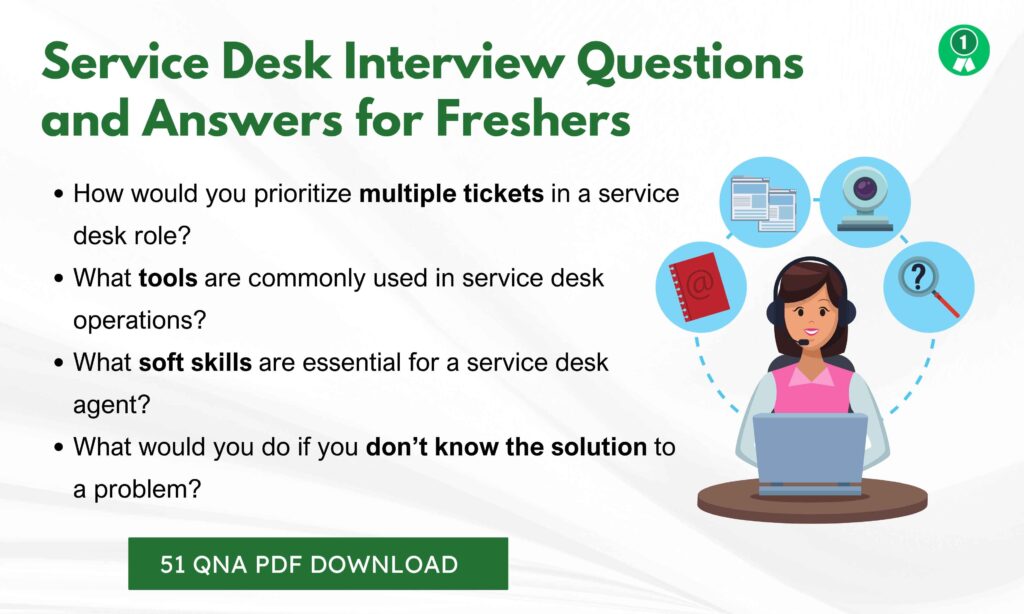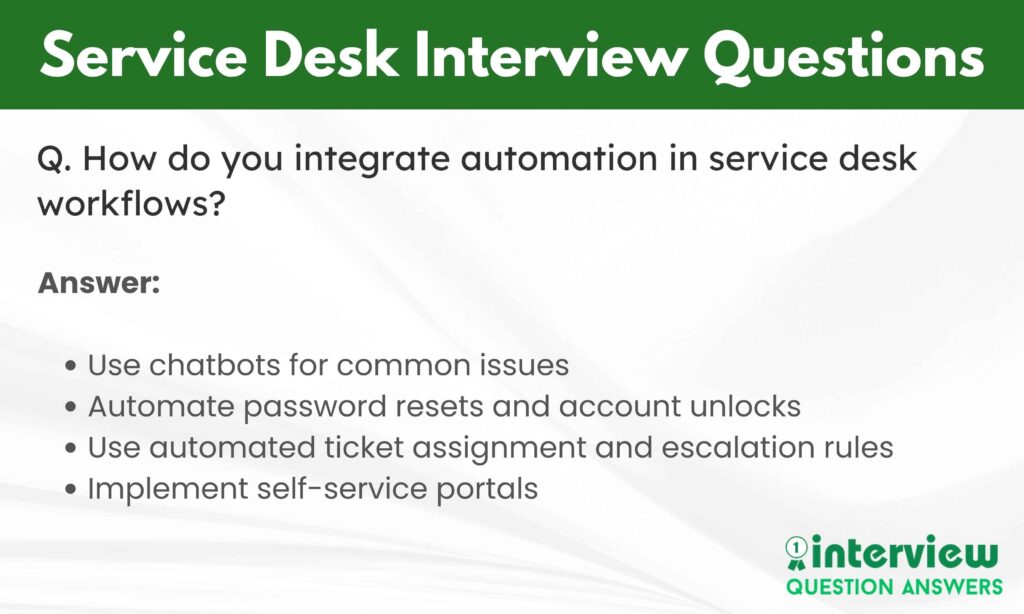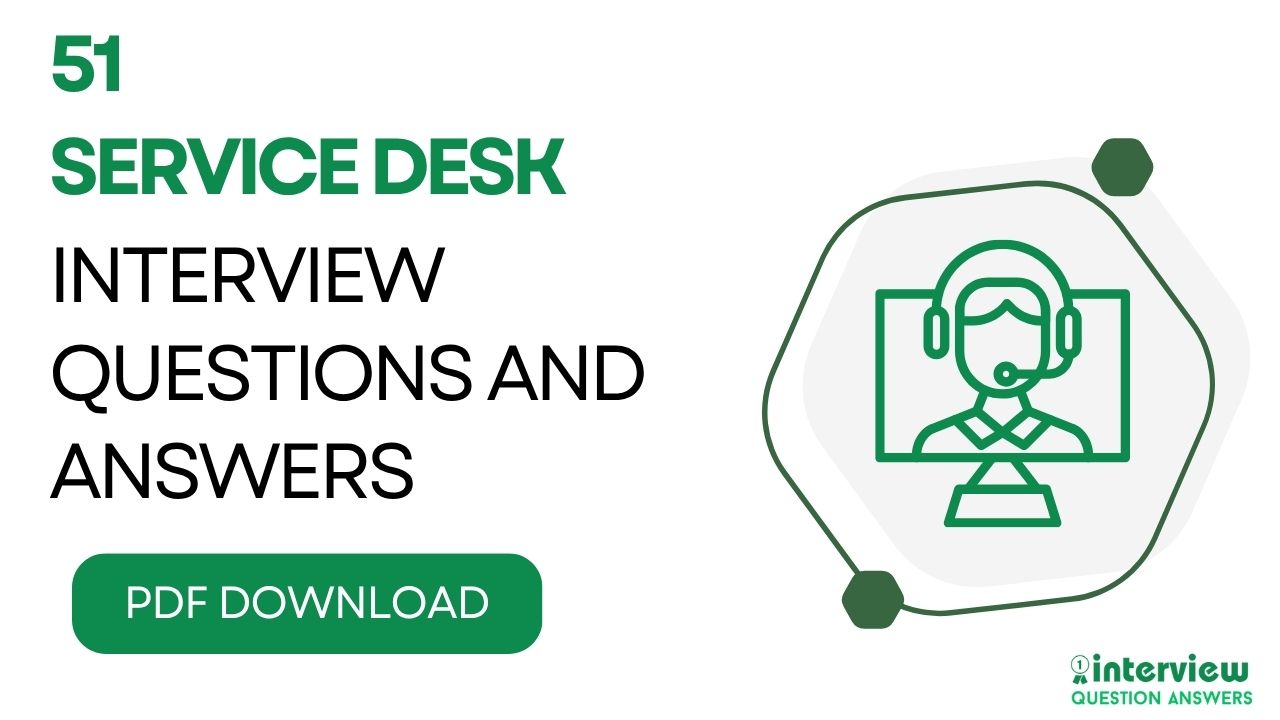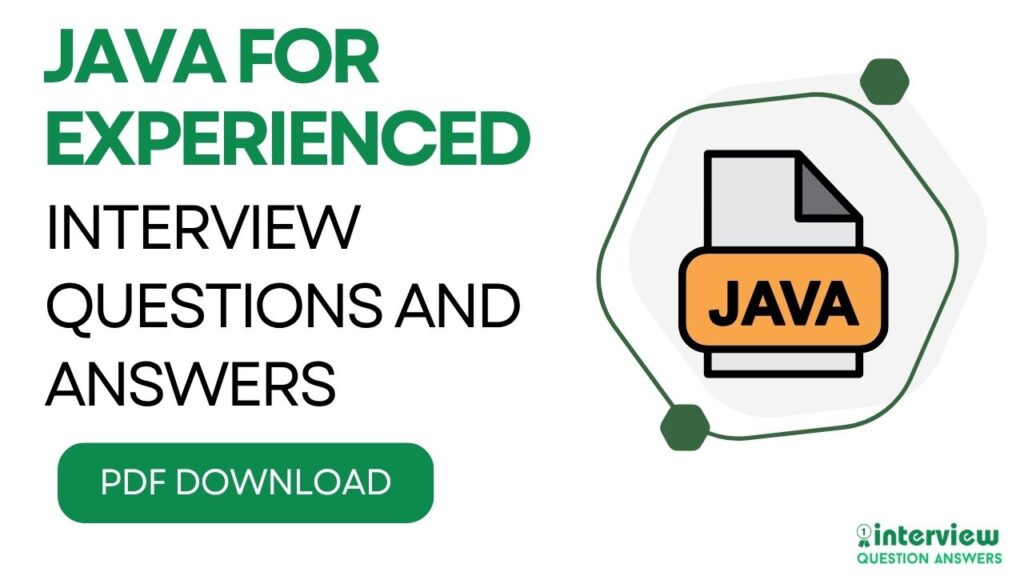A Service Desk plays a key role in IT support teams, acting as the main contact point for resolving technical issues and handling service requests. Service Desk professionals need both technical and customer service skills to solve problems efficiently and keep businesses running smoothly.
In this guide, we’ve shared a wide range of Service Desk interview questions and answers. From freshers-level basics to experienced-level technical questions, this guide covers every common challenges you might face in Service Desk roles.
We’ve also included specialized technical questions on networking, Active Directory, Windows troubleshooting, and more, making this guide useful for both Level 1 and Level 2 IT support roles. You can also download the set as a PDF to prepare offline easily.
Table of Contents
Service Desk Interview Questions and Answers for Freshers
Que 1. What is the primary role of a service desk in an organization?
Answer:
The service desk acts as the first point of contact between users and IT support teams. Its primary role is to resolve technical issues, handle service requests, and ensure smooth IT operations.
Que 2. What is the difference between a service desk and a help desk?
Answer:
A help desk typically focuses on solving immediate technical issues (break-fix support). A service desk offers a broader scope, including incident management, service request handling, and communication with other IT processes like change management.
Que 3. How would you prioritize multiple tickets in a service desk role?
Answer:
Tickets are prioritized based on their impact and urgency. Critical issues affecting many users or key business functions get higher priority, while minor problems affecting fewer users are handled later.
Que 4. What tools are commonly used in service desk operations?
Answer:
Common service desk tools include:
| Tool | Purpose |
|---|---|
| ServiceNow | IT service management and workflow automation |
| Freshservice | Cloud-based IT service desk and ticketing system |
| Jira Service Management | ITSM with integration to Jira for dev teams |
| BMC Remedy | Enterprise-level IT service management |
| Zendesk | Customer support and helpdesk ticketing |
Que 5. Explain what an SLA is in service desk operations.
Answer:
SLA (Service Level Agreement) defines the expected time frame within which a ticket must be acknowledged and resolved. It sets service standards to ensure consistent and timely support.
Que 6. What steps would you follow to resolve a password reset request?
Answer:
- Verify the identity of the user
- Reset the password through the appropriate system
- Inform the user of temporary password and login steps
- Ensure the user changes the password after logging in
Que 7. What soft skills are essential for a service desk agent?
Answer:
- Communication skills
- Patience
- Problem-solving attitude
- Active listening
- Empathy
These skills help agents handle users politely and effectively.
Que 8. What is incident management in a service desk?
Answer:
Incident management is the process of identifying, analyzing, and resolving incidents to restore normal service operations as quickly as possible.
Que 9. How do you handle frustrated or angry customers?
Answer:
- Stay calm and professional
- Listen carefully to understand the problem
- Empathize with their frustration
- Assure them that their issue will be addressed promptly
- Follow up after resolving the issue
Que 10. What is a knowledge base, and how does it help in service desk support?
Answer:
A knowledge base is a centralized repository of articles, solutions, and troubleshooting guides. It helps service desk agents resolve issues faster and ensures consistency in support.
Que 11. What would you do if you don’t know the solution to a problem?
Answer:
- Inform the user politely that you’ll escalate the issue
- Create or update the ticket with details
- Pass the issue to a higher-level support team
- Follow up to ensure resolution
Que 12. What is a ticketing system?
Answer:
A ticketing system is software used to track, manage, and resolve IT issues and service requests. It organizes tasks, logs interactions, and maintains service history.
Que 13. How do you document resolved issues in the system?
Answer:
- Record the steps taken to resolve the issue
- Mention any tools or commands used
- Include details about user interaction
- Save the resolution for future reference
Que 14. Why is first-call resolution (FCR) important in service desk operations?
Answer:
FCR measures how often issues are resolved during the first user contact. A high FCR rate improves customer satisfaction and reduces overall ticket volume.
Que 15. What’s the difference between an incident and a problem in ITIL terms?
Answer:
- Incident: An unplanned interruption to a service
- Problem: The underlying cause of one or more incidents
Que 16. What action would you take if you receive a high-priority alert after your shift ends?
Answer:
- Notify the on-call support team immediately
- Document the alert in the ticketing system
- Inform your manager or follow the escalation process
Que 17. How do you ensure customer satisfaction in a service desk job?
Answer:
- Listen actively to the user
- Communicate clearly and politely
- Resolve issues quickly
- Follow up after issue resolution
- Seek feedback where possible
Que 18. How can service desk agents improve their technical knowledge?
Answer:
- Regular training sessions
- Studying company knowledge bases
- Reading technical documentation
- Hands-on practice with systems
- Attending webinars and workshops
Que 19. What are service requests in ITIL?
Answer:
Service requests are formal user requests for information, advice, standard changes, or access to services. Examples include password resets and software installations.
Que 20. What is a major incident, and how is it handled?
Answer:
A major incident is a high-impact, urgent issue affecting business-critical services. It is handled with priority, escalated to senior support teams, and often involves a major incident manager to coordinate the resolution.

Also Check: IT Support Specialist Interview Questions and Answers
Service Desk Interview Questions and Answers for Experienced
Que 21. How do you manage SLA breaches in a service desk environment?
Answer:
Monitor tickets regularly using SLA dashboards. Escalate high-priority tickets as they approach SLA deadlines. In case of a breach, document the reason, inform management, and take steps to avoid recurrence.
Que 22. What is the purpose of ITIL in service desk operations?
Answer:
ITIL provides standardized practices for IT service management, helping improve service delivery, incident management, and change control. Following ITIL ensures consistency and efficiency in service desk processes.
Que 23. How do you differentiate between incidents, problems, and changes?
Answer:
| Term | Definition |
|---|---|
| Incident | An unplanned interruption or reduction in the quality of a service |
| Problem | The underlying root cause of one or more incidents |
| Change | The addition, modification, or removal of a service or component following a structured process |
Que 24. What is Problem Management, and how does it relate to the service desk?
Answer:
Problem management identifies and eliminates root causes of recurring incidents. The service desk reports recurring issues to problem management teams, contributing to long-term service improvement.
Que 25. How do you use reporting and metrics in managing service desk performance?
Answer:
Track metrics like first-call resolution (FCR), SLA compliance, average resolution time, and ticket backlog. Generate weekly or monthly reports to identify areas needing improvement.
Que 26. What challenges do you face in managing remote user support?
Answer:
- Limited visibility into user’s environment
- Connectivity issues
- Communication delays
- Security restrictions on remote access
Using remote desktop tools and clear communication helps overcome these challenges.
Que 27. How do you manage priority conflicts between multiple incidents?
Answer:
Assess the business impact and urgency of each incident. Involve stakeholders if required and use escalation matrices or predefined priority guidelines to resolve conflicts.
Que 28. How do you train and mentor junior service desk staff?
Answer:
- Share knowledge through walkthroughs and documentation
- Conduct mock troubleshooting sessions
- Encourage learning from real ticket resolution
- Provide constructive feedback during reviews
Que 29. How do you handle major incidents in real-time?
Answer:
- Notify the incident response or major incident team
- Initiate a conference bridge or war room
- Coordinate between technical teams
- Communicate status updates to management and users
- Document the incident for review
Que 30. What role does a Knowledge Management System (KMS) play in the service desk?
Answer:
A KMS allows storing and sharing solutions to common problems. It helps reduce resolution time, improve consistency, and facilitate training of new staff.
Que 31. Explain Change Management from a service desk perspective.
Answer:
Service desk agents help by logging change requests, validating their completeness, and sometimes participating in CAB (Change Advisory Board) reviews. After changes are implemented, the service desk handles user support for any post-change issues.
Que 32. How do you manage customer expectations in high-pressure situations?
Answer:
- Communicate transparently about progress
- Provide realistic timelines
- Offer temporary solutions if possible
- Follow up proactively and keep users updated regularly
Que 33. How do you handle VIP user support differently?
Answer:
- Prioritize VIP requests
- Offer personalized support
- Escalate promptly when necessary
- Ensure minimal downtime and follow up to confirm satisfaction
Que 34. What is shift-left strategy in service desk operations?
Answer:
Shift-left involves empowering Level 1 or self-service portals to handle more tasks that were previously escalated. This reduces workload on higher tiers and improves resolution time.
Que 35. How do you ensure data security while providing IT support?
Answer:
- Follow access control policies
- Avoid sharing sensitive information over insecure channels
- Use secure remote tools
- Adhere to company’s security and compliance guidelines
Que 36. How do you handle service desk ticket backlogs?
Answer:
- Identify aged tickets and prioritize them
- Assign resources strategically
- Automate routine tasks
- Review processes to address causes of backlog
Que 37. Explain the importance of documenting ticket resolution history.
Answer:
Proper documentation helps in knowledge sharing, speeds up resolution of recurring issues, supports audits, and ensures consistency across teams.
Que 38. What steps do you take during IT audits related to service desk processes?
Answer:
- Ensure complete ticket documentation
- Review SLA compliance reports
- Provide data on incident and request trends
- Demonstrate adherence to ITIL and security standards
Que 39. How do you integrate automation in service desk workflows?
Answer:
- Use chatbots for common issues
- Automate password resets and account unlocks
- Use automated ticket assignment and escalation rules
- Implement self-service portals
Que 40. What strategies help reduce incident volumes over time?
Answer:
- Regular problem management reviews
- Improve self-service resources
- Conduct end-user training sessions
- Use automation for routine tasks
- Keep infrastructure updated to prevent known issues

Also Check: IT Interview Questions and Answers
Technical Service Desk Interview Questions and Answers
Que 41. What are common network troubleshooting steps you follow in a service desk role?
Answer:
- Check physical connections
- Ping gateway and destination
- Use
ipconfigorifconfigto check IP settings - Test with
tracertortraceroute - Check firewall or proxy settings
- Escalate if hardware issues are suspected
Que 42. How do you handle DNS issues reported by users?
Answer:
- Flush DNS cache using
ipconfig /flushdns - Check DNS server settings
- Test using
nslookup - Verify domain resolution externally
- Escalate to network team if DNS server issues exist
Que 43. How would you troubleshoot a user unable to access a shared folder?
Answer:
- Verify network connectivity
- Confirm correct share permissions
- Ensure user is part of required AD group
- Check folder path and server availability
- Re-map the drive if necessary
Que 44. How do you unlock a locked Active Directory account?
Answer:
- Open Active Directory Users and Computers (ADUC)
- Locate the user account
- Right-click and select “Unlock Account”
- Communicate with the user regarding password policies
Que 45. How can you remotely assist users using built-in Windows tools?
Answer:
- Use Remote Desktop Protocol (RDP)
- Use Quick Assist in Windows 10/11
- Ensure user grants permission before connecting
- Confirm proper firewall and network access
Que 46. How do you handle printer issues reported by multiple users?
Answer:
- Check printer connectivity and power
- Verify printer is online in the print server
- Restart print spooler service
- Check for paper jams or low ink
- Reinstall printer drivers if needed
- Escalate hardware issues to vendor support
Que 47. What is BitLocker and how do you support users facing BitLocker recovery issues?
Answer:
BitLocker is a drive encryption tool in Windows. If users are prompted for a recovery key:
- Retrieve the recovery key from Active Directory or Azure AD
- Verify user identity before providing the key
- Educate users on saving recovery keys securely
Que 48. How do you troubleshoot slow system performance?
Answer:
- Check CPU, RAM, and disk usage via Task Manager
- Disable unnecessary startup applications
- Run antivirus/malware scans
- Clear temporary files and perform disk cleanup
- Recommend hardware upgrades if necessary
Que 49. How do you troubleshoot VPN connectivity issues?
Answer:
- Check internet connectivity
- Verify VPN client configuration
- Test with alternate VPN servers
- Check firewall/antivirus blocking VPN
- Escalate to network team if backend VPN service is down
Que 50. How do you manage software deployment via SCCM?
Answer:
- Use SCCM console to deploy applications or patches
- Target specific devices or user collections
- Monitor deployment status and resolve failures
- Troubleshoot using SCCM logs like AppEnforce.log
Que 51. How do you troubleshoot group policy issues on a user’s system?
Answer:
- Run
gpresult /rto check applied policies - Use
rsop.mscfor policy summary - Check for AD replication issues
- Force policy update with
gpupdate /force - Review event viewer logs for errors
Also Check: Technical Interview Questions and Answers
Service Desk Interview Questions PDF
We have provided a downloadable PDF containing all the Service Desk interview questions and answers shared in this guide. Download it now to prepare anytime, even without internet access. Use the PDF as a quick revision tool before your interview.
FAQs: Service Desk Interview Questions
What is the role of a Service Desk professional?
A Service Desk professional acts as the first point of contact for users facing IT-related issues. Their job involves handling technical support requests, resolving common problems like password resets or software issues, escalating complex problems to higher-level teams, and maintaining documentation for recurring issues.
What challenges do candidates face during a Service Desk interview?
During interviews, candidates often face questions related to troubleshooting scenarios, handling difficult customers, and explaining basic technical concepts. Many struggle with showcasing their communication skills and customer-first mindset, which are as important as technical knowledge in this role.
What are common job challenges for a Service Desk professional?
On the job, Service Desk professionals deal with handling a high volume of support tickets, managing frustrated users, multitasking between calls and chats, and working under pressure to meet SLAs (Service Level Agreements). Staying updated with new systems and internal processes also adds to the challenge.
How important is technical knowledge for a Service Desk role?
Basic technical knowledge is essential, such as understanding operating systems, email configurations, printers, and network basics. However, soft skills like clear communication, patience, and problem-solving ability are equally important to provide effective support and customer satisfaction.
What is the average salary of a Service Desk professional in the USA?
In the USA, entry-level Service Desk professionals typically earn between $45,000 and $60,000 annually. More experienced analysts or those in specialized support roles can earn up to $70,000 or more, especially in larger organizations or IT-focused industries.
Which top companies hire Service Desk professionals?
Many companies across industries hire Service Desk staff, including tech giants like IBM, Dell, Accenture, Infosys, Microsoft, and HP. Large enterprises in banking, healthcare, education, and government sectors also employ Service Desk teams to manage internal IT operations.
Why is interview preparation crucial for Service Desk roles?
Proper interview preparation helps candidates demonstrate their technical understanding and communication skills effectively. Practicing customer service scenarios, reviewing basic troubleshooting steps, and understanding common support tools can significantly improve chances in Service Desk interviews.
Conclusion
Preparing for a Service Desk interview requires understanding both IT support processes and technical troubleshooting. This guide has provided you with top questions asked in Service Desk interviews across various experience levels, covering customer service skills, ITIL processes, incident management, networking basics, system support, and real-life scenarios.







